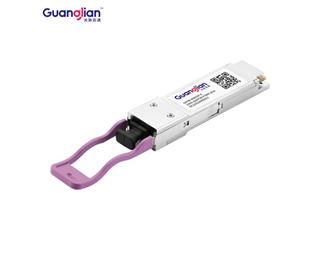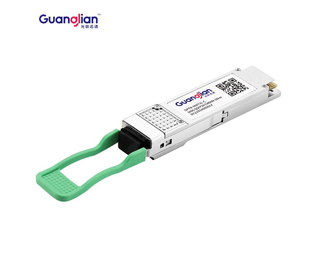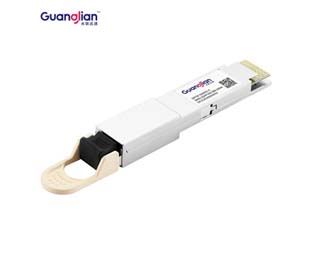Fiber Optic Transceiver is classified into various types to meet diversified requirements.
• Classified by transmission rates
The transmission rate is the number of bits transmitted per second. The unit of measure for transmission rate in Mbps (Megabits per second) or Gbps (Gigabits per second). Depending on transmission rates,fiber optic transceivers are classified into 0.5Mbps, 2Mbps, 10Mbps, 52Mbps, 84Mbps, 100Mbps, 155Mbps, 350Mbps, 622Mbps, 1Gbps, 2.125Gbps, 2.5Gbps, 3Gbps, 4.25Gbps, 6Gbps, 8Gbps,10Gbps, 16Gbps, 25Gbps, 32Gbps, 40Gbps, 56Gbps, 100Gbps, 120Gbps and 200Gbps.
• Classified by Package
By fiber optic transceiver package, they are classified as QSFP, QSFP28, CFP, CFP2, CFP4, CXP, SFP, CSFP, SFP+, GBIC, XFP, XENPAK, X2, 1X9, SFF, 200/3000pin, XPAK, etc.
100GBASE-QSFP28-PSM4-500m/2km Optical Transceiver Module
• Classified by fiber mode types
Optical fibers are classified into the single-mode fiber SMF and Multi-mode fiber MMF. Therefore, fiber optic transceiver is also classified as single-mode and multimode transceivers to support different optical fibers. The multi-mode transceivers usually have a transmission distance of 10km to 160 km, while the multi-mode one’s used for short transmission distances such as 0.5km to 2km.
• Classified by transceiver applications
There are many different transceivers for various applications. By different application,fiber optic transceiver are also classified into SONET/SDH,FE/GE/10GE/40GE/100GE Ethernet,Broadcast Video,CPRI,LTE,Fiber Channel,etc.
Fiber Optic Transceiver is widely found in wired networking applications such as Ethernet, Fibre Channel, SONET/SDH/ONT, CPRI, FTTx, and InfiniBand. The platform includes Ethernet switches, routers, firewalls, network interface cards, and fiber media converters. Storage interface cards, also called HBAs or Fibre Channel storage switches, also make use of these fiber optic transceivers for different speeds such as 2Gb, 4Gb, 8Gb, and 16Gb.
200G QSFP56
• Data Rate: the number of bits transmitted per second.
• Transmission distance: the maximum distance over which optical signals can transmit. Optical signals sent from different types of sources can transmit over different distances due to the negative effects of optical fibers, such as dispersion and attenuation. When connecting optical interfaces, select optical modules, and fibers based on the maximum signal transmission distance.
• Central wavelength: central wavelength represents the waveband used for optical signal transmission. At present, there are mainly three central wavelengths for common fiber transceiver modules: 850 nm, 1310 nm, and 1550 nm, respectively representing three wavebands.
• Optical Transmit power: Output optical power of an optic transceiver when it is working properly. When two optical transceivers are connected, the transmit optical power of one end must be within the range of received optical power on the other end.
100GBASE-QSFP28-LR4-10km Optical Transceiver Module
• Receiving sensitivity: the power at which the receiver of a fiber optic transceiver can receive optical signals within a range of bit error rate (BER = 10-12), in dBm.
• Fiber mode: Mode of optical fibers defined based on core diameters and features of optical fibers. Optical fibers are classified into single-mode (SMF) and multi-mode fibers (MMF). The multi-mode fibers have large core diameters and can transport light in multiple modes. However, the inter-mode dispersion is greater so they are used to transmit optical signals over short distances. Single-mode fibers (SMF) have a small core size and can transmit light in only one mode with a small dispersion, so they can transmit optical signals for long-reach communication distances.
• Connector Type: Type of the interface on an optic transceiver to accommodate a fiber. The Commonly used connector types are LC connector (applicable to QSFP, SFP, SFP+, SFF, and XFP transceivers), SC connector (applicable to BIDI SFP, GBIC, X2, XENPAK,1×9 transceivers), ST and FC connector (applicable to1x9 transceivers), MPO connector (applicable to QSFP+ SR4, and CXP modules).
• Extinction ratio: the Minimum ratio of the average optical power with signals transmitted against the average optical power without signals transmitted in complete modulation mode. The extinction ratio indicates the capability of an optical module to identify signal 0 and signal 1. This parameter is a quality indicator for fiber optic transceivers.
Guanglian is dedicated to research, development, manufacture, and market high-speed and high-performance optical transceiver modules and optical components for various ICT applications, such as Data Center, Telecom Networks, Security Monitoring. Our 100G QSFP28 can solve all compatibility problems for you, contact us!
100G CFP vs QSFP28: Which One to Choose?
Jun. 11, 2022What Makes the Best Optical Transceiver Module?
May. 27, 2022200G QSFP56 Optical Module Knowledge Full Explanation
Apr. 25, 2022
100G CFP vs QSFP28: Which One to Choose?
Jun. 11, 2022
What Makes the Best Optical Transceiver Module?
May. 27, 2022Copyright ©Guanglian Xuntong Technology Group Co., Ltd. All Rights Reserved | Sitemap
